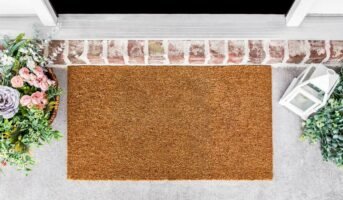We all want the first impression of their home to be flawless. As a result, we pay special attention to the design of the exterior of the structure or its facade. Contemporary homeowners often prefer a sleek and minimal look for their facades and are constantly seeking ideas that can help them achieve it. One such sought-after material for facades is glass. While glass surely adds the desired stylish touch, it is important to know how to use it correctly in facades for the best results. In this article, we will delve into the nitty-gritties of using glass for home facades.
See also: Toughened or laminated glass? Choosing safety glass door options
Types of glass for home facades
If you are considering the use of glass for your house’s exterior, it is important to keep in mind the types of glass that are most suited for the purpose. Here are some such types you can opt for:
| Types | Pro | Con |
| Low-emissivity (Low-E) glass | Its thin coating reflects UV and infrared rays to regulate indoor temperatures; improves energy efficiency by minimising heat transfer | More expensive than standard glass |
| Double/triple glazed glass | Made of multiple layers of glass with a layer of insulating gas in between for enhanced thermal insulation; improves energy efficiency and sound insulation | Heavier and more expensive than single-pane glass |
| Tinted glass | Reduces glare and control the amount of sunlight and heat coming in; provides additional privacy | Affects clarity of view and reduces natural light inside the house |
| Reflective glass | Reflective surface reduces solar heat by reflecting it; contributes to energy-efficiency | Limited visibility from outside; not versatile or compatible with all architectural styles |
| Tempered glass | Stronger, safer and more resistant to thermal stress; shatters into small, harmless pieces on breaking | More expensive than standard glass |
| Laminated glass | Has a layer of plastic between two glass panes for additional safety and security; does not fall apart when shattered, reducing the risk of injury | More expensive than other types |
| Frosted/acid-etched glass | Offer increased privacy without completely blocking out natural light; adds a decorative element to the facade | Limited visibility and streaming in of natural light |
| Self-cleaning glass | Has a special coating that uses rainwater to wash away dirt; requires minimal maintenance or regular cleaning | Upfront costs may be higher; effectiveness is subject to weather conditions |
| Smart glass | Has the ability to switch transparency through automation; offers enhanced privacy control | Higher initial costs; automation system might require regular maintenance |
Pros and cons of using glass for facades
Wondering if glass is a good choice of material for facades? Before you make up your mind, here is a list of pros and cons for you to consider:
| Pros | Cons |
| They allow abundant flow of natural light, making the interior bright and airy and reduce the need for artificial lighting during daytime. | They might compromise privacy, especially in densely populated areas, and require curtains or blinds to limit the view. |
| They have a contemporary and sophisticated aesthetic compatible with most architectural styles and provide unobstructed views, creating a sense of seamless dynamism between indoor and outdoor spaces. | They require regular maintenance and cleaning to retain appearance, subject to external conditions such as dirt and pollution. |
| With proper insulation, they can contribute to energy-efficiency by allowing passive solar heating. | They may cause increased heat gain in warmer climates, resulting in higher cooling costs, defeating the goal of energy-efficiency. |
| They promote a smooth flow between indoor and outdoor spaces for a sense of openness. | Quality glass suitable for exterior applications are expensive and customised designs used in large stretches might add to the overall co construction costs. |
| The modern and attractive appearance of houses with glass facades might be a USP and result in an increased valuation of the property. | Glass facade is more prone to breakage and can pose a safety risk; repairs or replacement might also be costly. |
| They can be used in various shapes and sizes, allowing for creative and customised designs. | Production of glass has environmental implications and transportation can also cause carbon emissions. |
Glass facade ideas
Still confused about the suitability of glass facades for your home? Here are some ideas you can refer to for some inspiration:
Floor-to-ceiling windows
This design can help blur the boundaries between interior and exterior spaces. Expansive floor-to-ceiling windows are perfect for a seamless space.
Glass walls with minimal frame
Slim and minimal framing can help maximise the glass area for enhanced sleekness. By ensuring maximum transparency, the facade can provide unobstructed views.
Glass sliding doors
Glass sliding doors can create a dynamic and flexible connection between indoor and outdoor spaces. If enhanced ventilation and visual continuity is what you’re looking for, this is the one for you.
Corner glass
Wrapping the glass around corners can open up panoramic views and create an illusion of a more expansive living space. Moreover, it also adds a unique and eye-catching architectural element.
Glass balustrades
Glass balustrades for balconies and terraces can maintain a sense of openness and transparency. As a result, the overall light and airy feel of the facade is enhanced.
Reflective glass
Reflective glass is the solution to your privacy woes. Additionally, they can help reduce glare and control the amount of sunlight entering.
Glass and natural materials combination
Strike a harmonious balance between modernity and wood by combining glass with natural materials like stone or wood. This fusion can enhance the visual interest of the facade.
Custom glass shapes
To introduce a unique and artistic element to the facade, you can experiment with custom-shaped glass panels or windows. This is particularly effective if you wish to make a bold statement or create a signature look for your home.
Glass with greenery
Incorporate a vertical garden or planter boxes against the glass facade to seamlessly integrate some greenery into the design. Alongside adding a dash of soothing greenery, it also provides shade and privacy.
Integrated lighting
Incorporate integrated LED lighting to enhance the visual appeal of your glass facade. By doing this, you can create a stunning effect during evening hours and highlight the architectural features.
FAQs
Is it possible to have energy-efficient glass for home facades?
Low-E glass and double or triple glazed glass windows are some energy-efficient options that help regulate heat loss or gain.
Can glass facades provide privacy?
Frosted, tinted or reflective glass are options that offer varying degrees of privacy. You can also consider using curtains, blinds or landscaping solutions.
Are glass facades safe for homes?
While glass facades are completely safe, you can consider using tempered or laminated glass for enhanced safety.
How can I maintain glass facades?
Glass facades require regular cleaning to ensure optimal transparency. Self-cleaning options are also available.
How can I enhance security with glass facades?
Laminated glass is a good choice for your security needs. For additional security features, you can go for smart glass technology.
Can I customise glass facades?
Glass can be used in versatile designs as it allows various shapes, sizes and customisations to achieve unique designs.
Do glass facades help with noise insulation?
Types such as double and triple layered glazed windows offer considerable sound insulation by reducing external noise.
| Got any questions or point of view on our article? We would love to hear from you. Write to our Editor-in-Chief Jhumur Ghosh at [email protected] |

Riddhi Chatterji is currently pursuing a master’s degree in English literature from University of Delhi. Her meticulous attention to detail and the desire to make a learning experience out of every opportunity has allowed her to work with different forms of textual content for digital platforms, ranging from social media to news desks. When not working or studying , you can find her with her head buried in a book, discovering new music and movies, or out and about exploring the city on the metro.











